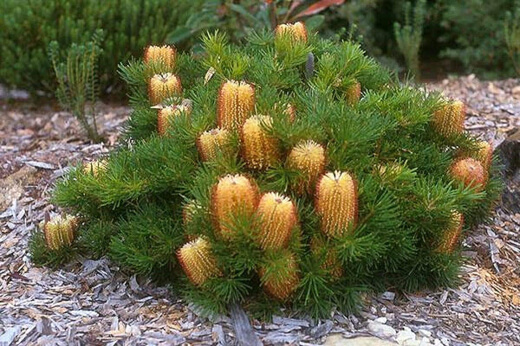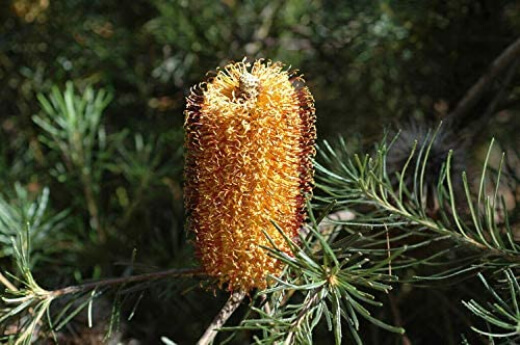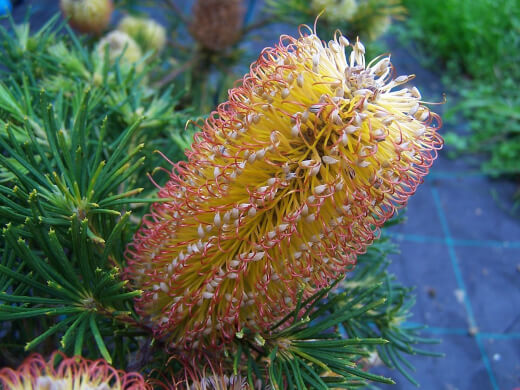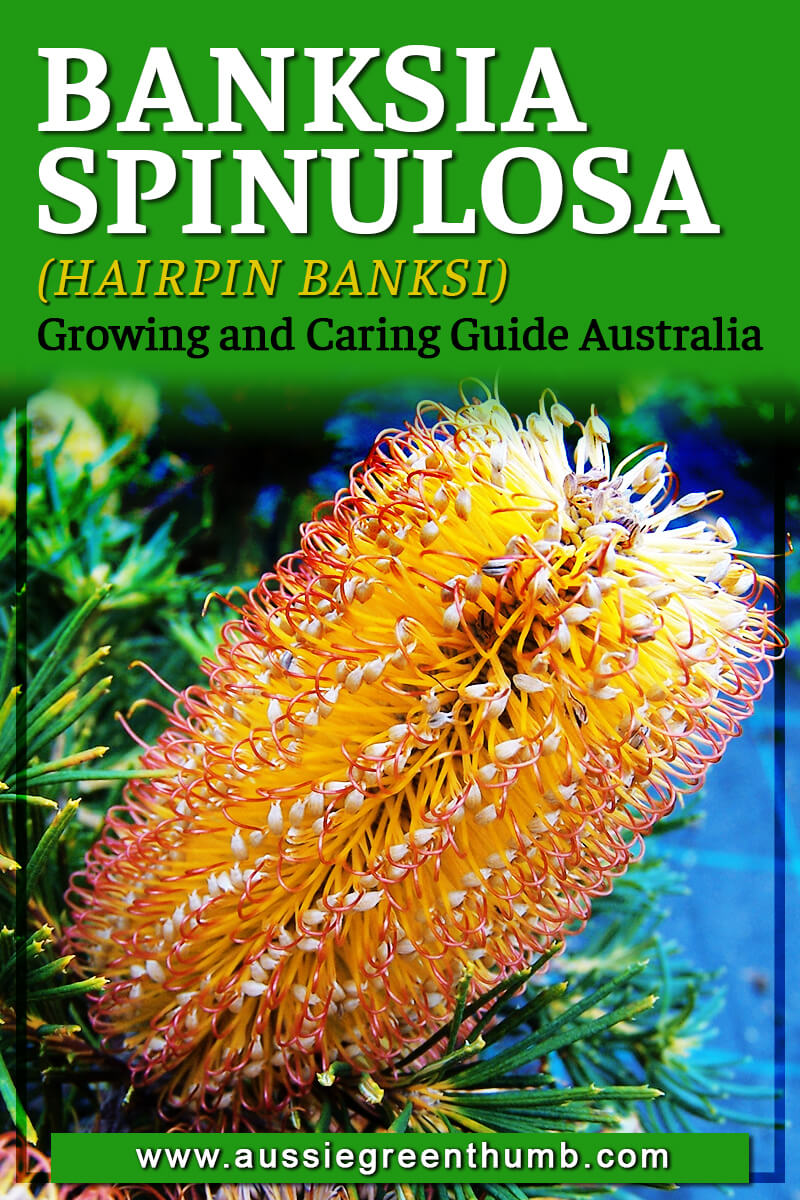The Banksia spinulosa, more commonly known as the Hairpin Banksia, is fabulous for first-timers and seasoned garden enthusiasts alike. This evergreen perennial is a striking addition to any garden, and with its incredible drought resilience, it’s quite an easy plant to care for.
Known for its breathtaking flowers which bloom into the shades of the sunset, the Banksia spinulosa can be grown in a variety of environments, even indoors. Not only that, but the Banksia also attracts plenty of wildlife to your yard!
More...
The Banksia spinulosa, also known as bush candles, is an easy addition to any garden. Whether you plant it in a pot, outside in some soil or even in rockier areas, the Banksia isn’t particularly picky and can survive in low nutrient soil.
Still, you want to make sure your Banksia gets enough of the good stuff. So, here’s everything you need to know to identify, plant, grow and care for your Banksia.
What is Banksia spinulosa?

Source: Amazon
The Banksia spinulosa, deriving from the Proteacae family, is in fact native to Eastern parts of Australia. While it is considered to be a medium to large plant species, on average growing about 1.8 - 3 metres in height, some varieties have grown as much as 9 metres tall.
However, dwarf varieties of the Banksia have been found along coastal areas, like New South Wales. As a plant with quite the extensive reach and varieties, it has accumulated many different nicknames such as'bush candles', ‘birthday candles’, ‘coastal cushions’, ‘honey pots’ and even the ‘stumpy gold’.
Originally, though, the Banksia was named to commemorate Sir Joseph Banks, a famed botanist who had travelled with Captain Cook. Spinulosa refers to the 3- 8 cm leaves, which are narrow and spindle-like.
Yet, its nicknames all elude to the plant’s fantastic floral expression. The Banksia forms oval-cylindrical clusters on the edge of the stem. These clusters comprise of many 10-20cm flower ‘spikes’ which range in colour from red, to orange and gold.
Its beauty has made the Banksia quite the sought-after plant in international gardens for centuries. In fact, Napoleon Bonaparte’s wife, Empress Josephine had actually cultivated a variety of Banksia for her garden at the Malmaison in Paris.
Banksia Birthday Candles
Birthday candles are a variety of Banksia spinulosa, and it’s often credited with starting the popular trend for all the different Banksia varieties! It’s a long-flowering, slow-growing plant that is very hardy as well as drought and disease-resistant once established.
Although it is a dwarf variety, it grows to a respectable 0.7m high and 1.5m wide over its lifetime. It is a huge favourite for nectar-eating birds, and does well in containers as well as being a good feature or screening plant.
To get the most flowers over the long March-September flowering period, make sure it gets plenty of sun, trim away dead flower heads, and only feed it small quantities of native plant fertiliser.
With tall, buttery-golden candle-like flowers tipped with red, it’s easy to see how this variety got its name and led the way for all the other ‘candle’ varieties of Banksia spinulosa!


Get Your Free Guide:
Master Growing Australian Natives eBook
A Must Have Complete Guide for Every Australian Garden
Get Your Free Guide:
Master Growing Australian Natives eBook
A Must Have Complete Guide for Every Australian Garden
Why Grow Banksia spinulosa?
Landscapers have long mused as to why the Banksia is such a great addition to a garden. Firstly, it is an easy plant to cultivate and grow. Plus, whether planted in a group or spotted around your garden the Banksia can add tremendous colour and texture.
When bunched together it has a distinctly dramatic effect, whilst sparsely placed can be a great little eye catcher. This – year-round too, due to its extended blooming cycle.
As a native of Australia the Banksia is able to grow in both warmer and cooler climates, with the only issues arising in particularly humid climates. It really is best known for its resilience, which translates into its incredibly long-life span. Did you know Banksia can live up to 100 years?
More so, the Banksia is beneficial to your local ecosystem. Its flowers provide a nutrient-rich pollen, which attracts many bees, birds and butterflies and will support your local ecology.
How to Grow Banksia spinulosa

Source: Amazon
Whether you’re planning for the garden or for a pot, propagating your Banksia from a seed is probably your best option. Still, it is possible to grow a Banksia from a cutting, though it Is rumoured to be slightly more difficult.
Growing Banksia spinulosa from Seed
- You can cultivate your seed either in a seed tray, in a pot or simply in the ground.
- Ensure your soil remains moist – by means of a mister.
- Avoid overly wet soil.
- Seeds should germinate between 2-8 weeks.
Growing Hairpin Banksia from Cutting
- If you are considering this option, ensure you take a cutting during late spring.
- Cuttings which are 1 – 2.5 cm in length, should suffice.
- Make sure you remove all leaves.
When planting, ensure your root stock is placed on a low heap of soil within the hole, then fill the rest with a gravel mulch. This will promote optimal drainage for your plant.
Where to Grow Hairpin Banksia
Though the Banksia is a fairy, no-fuss fauna there are certain things it needs to survive. The main things you will need to consider is the sun, soil and drainage.
Sun
Your Banksia will be happiest is a spot which gets plenty of sunlight and some solid air flow. This is why it is an ideal garden plant. Still, nothing stops you from finding the perfect spot in your house.
Soil
Banksia are blessed with specialised proteoid roots, that allow them to grow in low nutrient soil. This means that even in not-so-optimal soil situations, the Banksia will still survive.
Though not phased by acidic or alkaline soils, the Banksia is however particularly sensitive to phosphorus. If you’re worried, perhaps treat your soil to some fertiliser.
Drainage
Good soil drainage is quite possibly the most important aspect when looking at the growing conditions for the hairpin banksia. It is a drought-tolerant plant, so it tends prefers dry soil over wet. Well-draining soil will ensure optimal plant health and happiness.
Hairpin Banksia Care Instructions

Whilst your hairpin banksia will require largely little attention, there are certain things you can do to ensure it has a long, beautifully-blooming life. It is, however, important to note that flowering will only start a few years in. Nonetheless, when it does bloom, it proceeds to do so from autumn all the way into spring.
Here’s what you can do to care for your Banksia:
1. Watch Your Watering
Over-watering is a big issue with banksia’s, however, in its first two years you will need to ensure it is watered regularly.
Thereafter, a seasonal rain-shower or occasional watering will suffice.
Cut back during particularly wet seasons.
2. Be Picky with your Pruning
The Banksia requires little to no pruning and can be done purely to control size and shape.
Dead flowers can be cut off (but do offer their own beautiful aesthetic as they wither and eventually fall).
3. A Nutritional Nudge
Though it’s not always necessary, you can give your banksia some extra nutrients and minerals from time to time.
Consider adding an iron-rich fertilizer or some mulch to your soil.
Watch Your Watering
- Over-watering is a big issue with banksia’s, however, in its first two years you will need to ensure it is watered regularly.
- Thereafter, a seasonal rain-shower or occasional watering will suffice.
- Cut back during particularly wet seasons.
Be Picky with your Pruning
- The Banksia requires little to no pruning and can be done purely to control size and shape.
- Dead flowers can be cut off (but do offer their own beautiful aesthetic as they wither and eventually fall).
A Nutritional Nudge
- Though it’s not always necessary, you can give your Banksia some extra nutrients and minerals from time to time.
- Consider adding an iron-rich fertiliser or some mulch to your soil.
Banksia Pest Problems
Although, it will invite many curious, nectar-seekers to your garden- the Banksia is not particularly susceptible to pest problems. The most you may come across is a caterpillar, which are quite easily identified and managed.
Most varieties of caterpillars eat very little and as such will do minimal damage to your plant. However, varieties such as the Grevillea looper, have larger appetites and can become problematic to your plant.
Luckily, these are easily taken care of with a natural insecticide which can rid you of your pest problem without harming your plant or the animals which may feed from it.
Diseases To Look Out For
Diseases are the main cause of death in Banksia plants and stem largely from inadequately draining soil, its phosphorous sensitivity and attacks from a fungus.
The Banksia is particularly susceptible to cinnamon fungus- an ever-present issue posing threat to Australia’s ecology.
Should your Banksia be looking somewhat worse for wear, look out for the following diseases:
Root Rot
- Root rot is a common problem and can pose deadly for many plants.
- The most obvious signifiers are brown and withered leaves which remain attached to the plant.
- To combat root rot, ensure you have well- draining and balanced soil. You can also consider adding some compost to rebalance the soil.
Here is our review of the best compost bins for 2025.
Phosphorus Toxicity
- An imbalance of phosphorus in the soil can lead to the poisoning of your plant. The biggest problem here is that poisoning can happen over a long period of time and not always noticed.
- To pick up if your plant is suffering from phosphorus poisoning look out for yellowed leaves with brown tips.
- A seaweed soil care will help neutralize your soil.
Cinnamon Fungus or Dieback
- Dieback is a massive threat on Australian ecology that has even been listed in the Environment Protection and Biodiversity Conservation Act.
- Unfortunately, the Banksia species is prone to cinnamon fungus and it can have deadly effects on your plant.
- There are chemical treatments, however, prevention is always better. Perhaps consider raised beds as they will help protect your plant and allow you to regulate contaminants in your soil.
- Moreover, if you are traveling through or have been in areas (whether hiking or camping) which are known to suffer from dieback, make sure to follow precautions and hygiene recommendations that will prevent spread.
Banksia spinulosa Growing and Caring Guide Summary
Well, now you know- everything to look out for when growing and caring for your Banksia plant.
As long as you ensure, well-draining soil and a sunny spot, your Banksia should be fairly happy and care-free. You can enjoy a gorgeous flowering plant in your garden, with largely minimal effort.
Whether, from a seed or cutting, make sure you don’t over-water your plant and keep a keen eye for any potential problems. Cut-to-size or left to grow, your Banksia will bloom from Autumn to Spring and will do so for a century.
That is why the Banksia spinulosa or hairpin banksia is the ideal addition to your garden.

Published on September 21, 2021 by Gary Clarke
Last Updated on January 19, 2025




